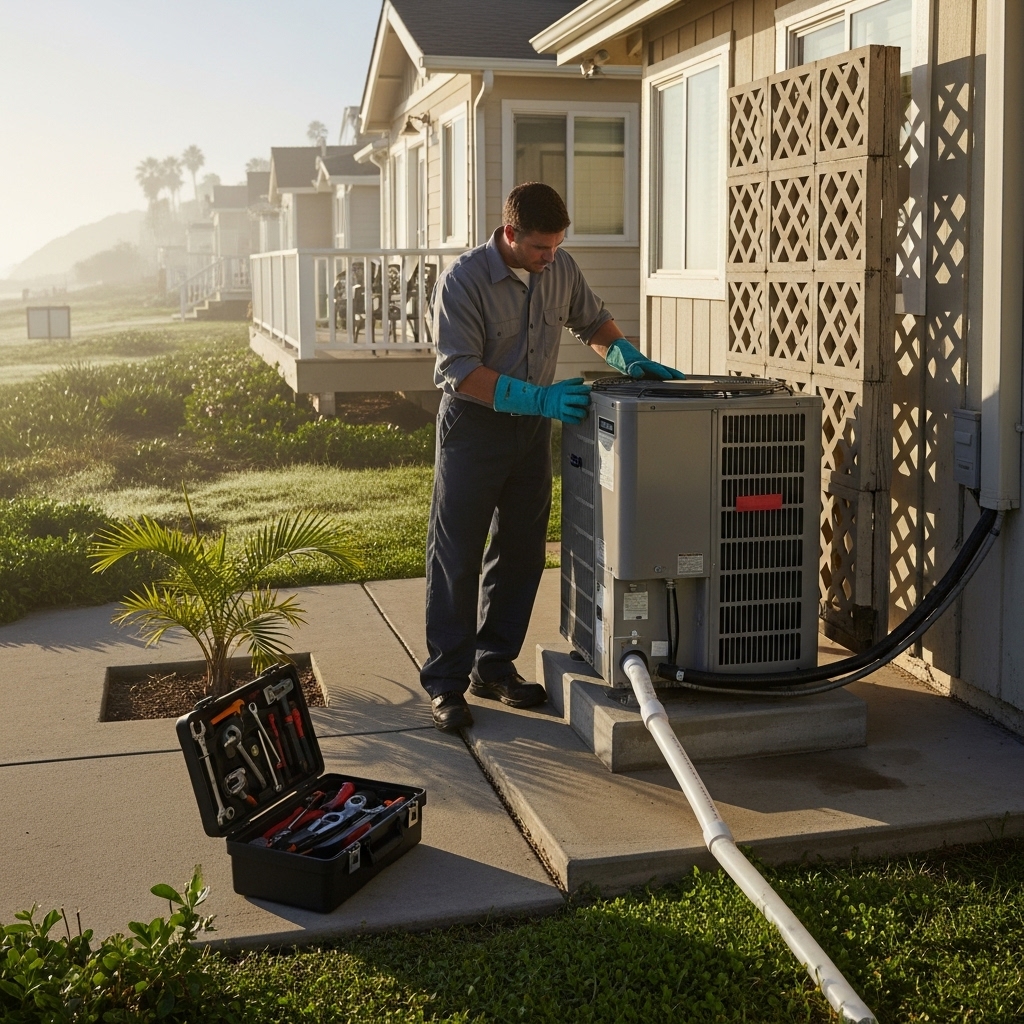Finding the right air conditioning installation services near you in Malibu, California means partnering with professionals who understand coastal conditions, neighborhood logistics, and energy code requirements. Malibu’s ocean influence, hillside access, and microclimates call for solutions that are more nuanced than a one-size-fits-all approach. Whether you live near the beach, in a canyon, or along the ridgeline, this guide explains how local providers plan, install, and support cooling systems so you can enjoy quiet, efficient comfort. If you are comparing options for air conditioning installation, use this resource to clarify what to expect and how to evaluate nearby services.
Local expertise matters. Service teams familiar with Malibu know how fog, wind, and salt air affect outdoor equipment, how to route ducts in tight attics, and how to protect views while maintaining clearances and service access. They also understand Malibu building permits, Title 24, and HERS testing where required. This combination of technical skill and local knowledge helps projects finish on time and perform as intended.
What Local Installation Services Typically Include
- In-Home Assessment: Review of comfort goals, hot rooms, noise concerns, and aesthetic priorities.
- Load Calculations: Manual J or equivalent sizing tailored to your home’s construction and exposure.
- Duct Evaluation: Testing and inspection to identify leakage, undersized runs, or poor layouts.
- System Options: Central split, ductless, or heat pump recommendations with efficiency and control strategies.
- Permitting and Compliance: Handling Title 24, HERS coordination, and municipal inspections.
- Installation and Commissioning: Professional installation, safety devices, start-up, and documented performance checks.
- Orientation and Follow-Up: Thermostat setup, maintenance guidance, and post-installation support.
Matching System Types to Malibu Homes
Beach homes may favor ductless mini-splits for targeted cooling where duct runs are impractical. Hillside homes often choose central split systems with zoning to manage temperature differences between levels. For many properties, heat pumps offer efficient cooling and comfortable heating in shoulder seasons. Your provider should compare noise ratings, corrosion resistance, and smart thermostat compatibility to pick the best fit for your space and lifestyle.
Coastal Durability and Quiet Operation
Salt air can be tough on metal components, so look for coastal-rated condensers with protective coatings and stainless hardware. Ask about locating the outdoor unit where it has free airflow and minimal exposure to salt spray or high winds. Acoustic considerations also matter in Malibu’s serene neighborhoods. Variable-speed compressors, anti-vibration pads, and careful placement reduce noise for you and your neighbors.
Electrical, Condensate, and Safety Details
Reliable installations address more than just cold air. Electric circuits are verified for capacity and breaker sizing, condensate drains are sloped and trapped per manufacturer guidance, and float switches prevent overflow. Technicians secure and insulate refrigerant lines, seal wall penetrations, and use UV-resistant insulation to withstand sun exposure. These details produce safer, more dependable systems.
Smart Controls and Zoning
Smart thermostats, sensors, and zoning panels tailor comfort to how you live. A multi-level home near the coast can benefit from zoning to minimize temperature stratification and reduce energy use during mild periods. Local installers help you pick compatible controls, place thermostats away from sun and supply vents, and fine-tune schedules for Malibu’s daily temperature swings.
How Local Providers Streamline the Process
Nearby teams shorten lead times for site visits, permitting, and inspections. They know where equipment can be staged, how to access tight drives, and when to schedule deliveries. They can quickly address punch-list items and provide follow-up service because they are close by. For you, that means less disruption, faster communication, and a smoother installation experience from start to finish.
Questions to Ask an Installer Near You
- How do you size systems for Malibu microclimates and solar exposure?
- What corrosion protections do you recommend for coastal air?
- Can you show examples of quiet installations in similar neighborhoods?
- How will you manage duct leakage and balance airflow?
- Who handles permits, HERS testing, and inspections?
- What commissioning data will I receive at the end?
- How do you support maintenance after installation?
Signs of a High-Quality Local Service
- Uses load calculations rather than rules of thumb.
- Provides clear scope, including duct sealing and safety devices.
- Plans condenser placement for airflow, appearance, and noise.
- Documents commissioning results and educates the homeowner.
- Responds promptly and communicates scheduling changes.
Special Considerations for Malibu Homes
Beyond corrosion and noise, Malibu homes benefit from strong indoor air quality strategies. High-efficiency filtration, sealed returns, and attention to infiltration can keep interiors clean and comfortable. If wildfire smoke occasionally affects your area, discuss filter upgrades compatible with your system and how to operate during smoke events. When remodeling, improving insulation and air sealing can reduce cooling loads and allow for smaller, quieter systems.
Maintenance: Protecting Your Investment
Nearby providers make ongoing care convenient. Regular filter changes, coil cleaning, drain line checks, and seasonal tune-ups maintain efficiency and reliability. For coastal homes, periodic rinsing of the outdoor coil removes salt residue. Tracking system behavior through smart thermostats can reveal trends that suggest a professional check, such as unusually long runtimes or difficulty reaching set points.
Comparing Multiple Local Quotes
When you gather proposals, compare more than equipment models. Look closely at duct improvements, corrosion protection, thermostat strategy, condensate safety, and commissioning steps. Ask for references in your neighborhood and examples of similar installations. A thorough proposal that addresses Malibu-specific challenges often predicts a smoother project and better long-term performance.
When Timing Matters
Heat waves and holiday schedules can tighten availability. Local teams may be able to respond faster with flexible staging or phased work. If you have upcoming travel or hosting plans, share your timeline early so the provider can coordinate permitting and inspection dates accordingly.
Partnering with a Team That Knows Malibu
Proximity is useful, but local know-how makes the real difference. Choose installers who can explain how they’ll protect your home, plan for coastal conditions, and verify results with commissioning data. If you want support from consultation through follow-up with professionals who focus on air conditioning installation, prioritize experience in Malibu neighborhoods similar to yours.
Frequently Asked Questions
Q: How do I know if a contractor truly understands Malibu conditions?
A: Ask for photos or references from nearby projects, examples of corrosion protection choices, and details on how they handle wind, salt, and access challenges. Their answers should be specific, not generic.
Q: Are heat pumps popular in Malibu?
A: Yes. Heat pumps offer efficient cooling and comfortable heating for Malibu’s mild winters. Variable-speed models are especially quiet and effective in coastal climates.
Q: What about ductless systems for additions or guest houses?
A: Ductless mini-splits shine in spaces without existing ducts or where zoning is beneficial. They offer efficient, targeted comfort and a relatively quick installation.
Q: Do I always need new ducts when replacing equipment?
A: Not necessarily, but many homes benefit from duct sealing, select resizing, and return improvements. A thorough assessment will indicate whether changes are needed.
Q: How can I minimize installation noise?
A: Schedule work when it’s convenient, use protective coverings to reduce echoes in empty rooms, and choose equipment with quiet ratings. Outdoor placement and vibration control are also key.
Q: Will my project require HERS testing?
A: Many Malibu installations do, especially when ducts are altered or replaced. Your contractor should explain the tests needed and coordinate the verification.
Q: What documentation should I receive at the end?
A: Commissioning readings, model/serial numbers, filter sizes, warranty registration details, and maintenance recommendations. Keep these for future service and insurance records.
Move Forward with Confidence
With the right local partner, your installation will be tailored to your home’s architecture, your comfort priorities, and Malibu’s environment. Clear planning, careful execution, and responsive support deliver cool, quiet spaces that enhance daily life.
Start Your Project with a Nearby Expert
If you are ready to upgrade comfort with a team that combines local knowledge and technical excellence, schedule your air conditioning installation with trusted Malibu professionals and enjoy a smoother experience from first visit to final walkthrough.

